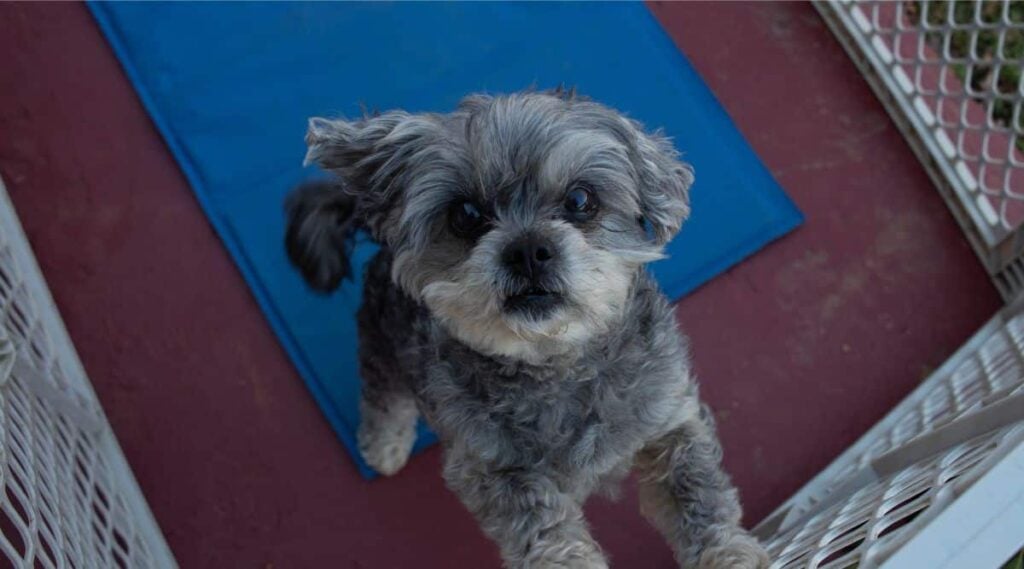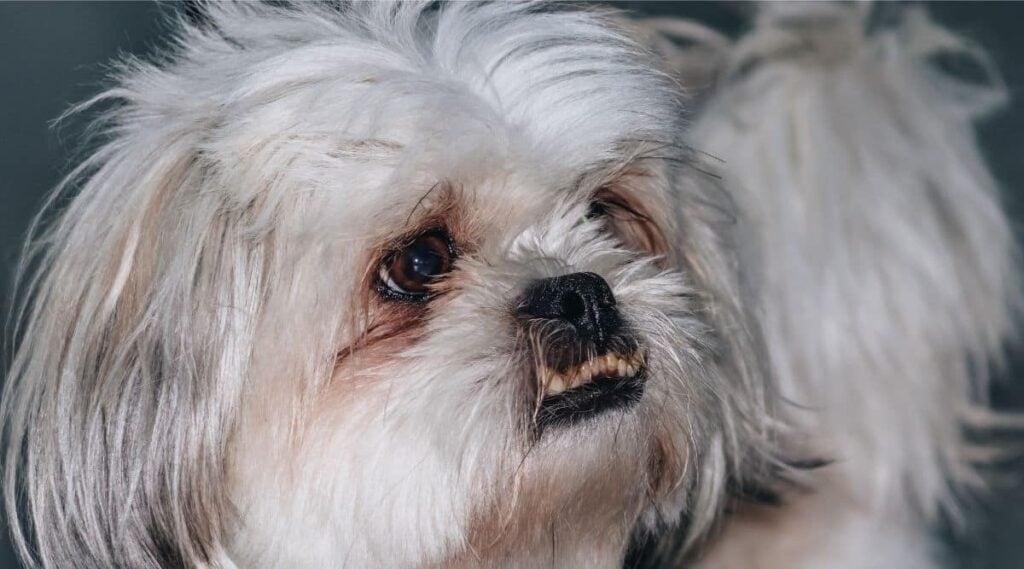Peekapoo: Pekingese Poodle Mix Traits, Facts & More
When you purchase through links on our site, we may earn a commission. Here’s how it works.
While many people love dogs, most people don’t love dog hair. Several half-Poodle “designer” blends have been created to offer options to people who love dogs but want less dog hair in their homes. Although the Labradoodle and Goldendoodle have been trending recently, the Peekapoo was one of the first blends to capture its own following over a half-century ago.
Table of Contents
Humans have used dogs to help them as hunters, guardians, pack animals, and loving companions for millennia. The Poodle was originally bred to retrieve game for hunters, but the Pekingnese was explicitly crafted for his lionlike look and dauntless disposition.
If you think a Pekingese Poodle blend, or Peekapoo, might be the perfect addition to your family, consider the traits of his two parent breeds. Understanding the characteristics of these two intelligent breeds will help you choose the best pup to be your sidekick.
Pekingese

Legend has it that the Buddha created the Pekingese, who shrank a lion to the size of a dog. The Pekingese was designed to resemble the imperial city’s mythical foo dogs or guardian lions. Like most legends, it may have its origins in truth. The Pekingese, known casually as the Peke, was likely created by choosing smaller individuals and, over the years, breeding them smaller and smaller in the courts of the Emporers.
His thick undercoat adds a layer of insulation under his long, coarse outer coat that stands off his body, further increasing his apparent size. Their luxurious coats require regular bathing and brushing to be at their best. Bathing the Peke’s face takes skill and patience, as his upturned nose has to be protected when rinsing. Pekingese do shed, but their outer coat tends to catch the undercoat hairs they shed.
Poodle

Originally bred to be a retriever like the Labrador, all sizes of Poodle are used in crossbreds to reduce the amount of hair and dander during shedding season. The original Standard Poodle was a working water dog. His dense, curly, low-shedding coat kept his vital organs and joints warm while retrieving birds from the cold water.
The intelligence and trainability of the Poodle made it popular with the circus industry. Handlers bred down their size to make the dogs easier to carry on the circus trains from city to city. These smaller Poodles gained popularity with allergy sufferers who found their low shed coat beneficial in reducing allergens in the home.
Pekingese Toy Poodle Mix
The Peekapoo is one name for the Pekingese and Toy Poodle blend. The Peke is, by definition, a first-generation cross, meaning a Peekapoo’s parents are a purebred Pekingnese and a purebred Toy or Miniature Poodle. They’re not a product of a Peekapoo/Peekeapoo cross. Peekapoo may be spelled Pekapoo or Peke-apoo.
Although blending these two elegant breeds creates a charming companion, these breeds come from very different backgrounds. The Pekingese and the Poodle each have strong personalities. Crossing two small breeds with differing facial and body structures and different temperaments may produce a range of types, but all should be fun additions to the family.
Temperament

Both parent breeds of this diminutive mix are independent thinkers. Pekingese tend to be “opinionated,” in the words of Peke aficionados. As small as they are, they are fiercely loyal. They were used as personal protection devices in ancient Chinese imperial courts. Emporers and courtiers would place the most diminutive and most pugnacious in the loose sleeves of their garments.
The Poodle’s intelligence makes him easily trainable but sometimes high-strung. People pleasers at heart, toy and miniature Poodles are more athletic and agile than their fluffy appearance would suggest. Combining two different body and personality types means your Pekeapoo will be an individual and likely have varying personality traits from both breeds. Be sure the breeder from whom you plan to buy your puppy has carefully chosen the parent dogs for this blend.
Size & Appearance
A Peekapoo will be small like his parent breeds. The Toy Poodle maxes out at ten inches, and the Pekingese is only six to nine inches at the shoulder. Your Peekapoo will likely be under ten inches tall and weigh between ten and fifteen pounds. If your Peekapoo has a Miniature Poodle for a parent instead of a Toy Poodle, he may be a few inches taller and weigh up to twenty pounds.
Your Peekapoo will likely be more athletic than his Shih Tzu parent because Poodles descend from strong swimming hunting dogs. Even Toy Poodles are fairly athletic for their size and bring energy and athleticism to this blend. A responsible breeder should be able to show you the parent dogs and estimate mature size and type based on other litters.
Coat & Colors
In dogs, curly hair is dominant to straight hair, and short hair is dominant to long; your Peekapoo will likely have a coat that looks more like his Poodle parent but likely with a thicker undercoat. The Pekingese can be any color, so color depends on your particular pup’s parents.
Poodle blends often shed less than other mixed or pure breeds, but no breed is hypoallergenic. Dog allergies are typically triggered by the protein in your dog’s saliva, dander, and urine. If your Peekapoo’s coat is more like his Poodle parent’s, his hair will be caught in his curls.
Exercise & Living Conditions

Your mix may not be able to keep up if you’re jogging, but your Peekapoo will relish an easy walk or two through the neighborhood. A twenty or thirty-minute walk once or twice a day, depending on his build, should provide him with sufficient exercise.
Because both parent breeds are small, your blended pup will fit in many living spaces. Whether you live in a suburban home or an apartment in the center city, your Peekapoo fits nicely no matter the location. His clever Poodle side will enjoy learning tricks or navigating agility obstacles, but his Pekingese side may be aloof and more interested in being petted than performing.
Training
A Peekapoo may challenge you during training time. Both parent breeds are intelligent, and your pup may take after either parent or be somewhere in between. You may need patience training your Peekapoo because of his challenging blend of cleverness and independence. Reward positive behavior and be sure he gets enough mental stimulation to help him be calm when he has to stay home alone.
Socialize your Peekapoo early with other dogs so he’ll be calm around other family members, pets, and pups. If you acquire him as a puppy, keep an eye on him with larger animals in the home because his tiny body size puts him at risk, and he may inadvertently be hurt by rough play. Teach him basic obedience commands while he’s still a pup, and get him used to daily grooming, although his coat will change as he becomes an adult.
Health

From his Toy Poodle side, he brings a tendency towards tracheal collapse, bladder stones, Cushing’s disease, sebaceous adenitis, von Willebrand’s disease, and idiopathic epilepsy. He may have a tendency towards hip dysplasia, patellar luxation, Legg-Calve-Perthes disease, and cardiac and eye disorders like Progressive Retinal Atrophy (PRA).
Pekingese have a brachycephalic profile, but crossing with the Poodle’s longer muzzle gives the Peke a lower likelihood of breathing problems and subsequent fatigue. Pekes are prone to intervertebral disc disease, early onset heart disease, and syringomyelia, a neurological disorder where a fluid-filled cyst forms within the spinal cord. Check in with your vet if you notice any vision changes in your pup.
Nutrition
Feed a high-quality kibble that meets the Association of American Feed Control Officials (AAFCO) standards to keep your Peekapoo healthy with strong teeth and healthy gums. Choose a formula designed for your best friend’s specific life stage. Monitor your pup’s weight and activity, as he may tend to pack on the pounds.
Provide portions according to the weight chart on your food brand, and keep an eye on his body condition to adjust his intake. Choose a low-calorie formula as needed. A high-quality kibble including meat protein, fiber, healthy carbs, omega-3 fatty acids, vitamins, and minerals will meet your petite blend’s nutritional needs.
Grooming

One of the most appealing features of this designer blend is his silky low-shedding coat. Although he does shed, his shedding is manageable with some grooming. Daily grooming with a pin brush helps prevent matting. Bathing him once every month or two helps remove loose hair trapped in his coat.
Breeders & Puppy Costs
Pekingese Toy Poodle blends are always in demand, even though this mix is not an actual breed and cannot be registered. His personality, small size, and low-shedding coat make him a great addition to most households. Peekapoo pups may cost over $1000, but the price will depend on demand in your area.
Rescues & Shelters

Petfinder is always a great place to get started. Rescue organizations dedicated to each parent breed also offer mixes for adoption, and many small breeds are crossed on Poodles. These include poodle cross rescues such as Rescueme for Poodles and Carolina Poodle Rescue.
As Family Pets
In General, Peekapoos:
- Are compatible with older children.
- Are intelligent but could be a bit hard to train.
- Can live comfortably in an apartment with daily exercise.
- Get along with other dogs but can be happy as an only pet.
- Shed little, but require daily brushing to avoid matting.
- Often bark in alarm but are generally friendly.
Final Thoughts
If your lifestyle requires a companion who can live in a small place, consider the Pekingese Toy Poodle mix, commonly known as the Peekapoo. This charming blend has been winning hearts since the 1950s. A balanced blend of affection and independence, this adorable pup isn’t afraid to bark at any perceived danger. Ultimately, however, his preferred place is in the lap of the one he loves – on his terms, of course.



